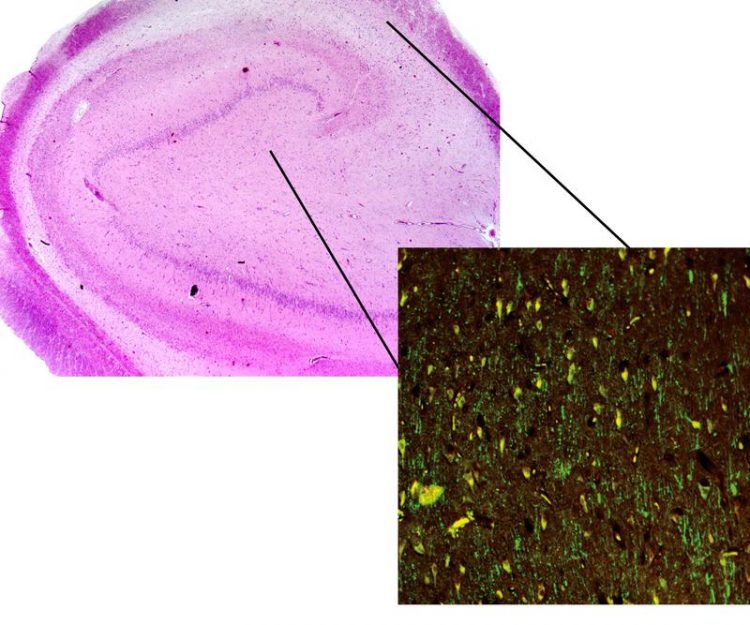Dragnet for epilepsy genes

Surgical specimen of an antiepileptic-resistant patient with temporal lobe epilepsy, which represents a unique access to the human brain tissue (upper left). (c) Photo: Arbeitsgruppe Albert Becker/UKB
In doing so, they discovered the molecule sestrin-3 as a central switch. In animal models, the scientists were able to demonstrate that inhibition of sestrin-3 leads to a reduction in seizures. The results are now being presented in the renowned journal “Nature Communications”.
During an epileptic seizure, many nerve cells lose their regular rhythm and switch into a rapid rhythm. This results in seizures to the point of a loss of consciousness. The temporal lobes in the brain are most frequently the region in which such synchronous discharges occur.
“Drugs have the desired effect in only about two-thirds of patients with temporal lobe epilepsy,” says Prof. Dr. med. Albert Becker from the Institute of Neuropathology of the University of Bonn Hospital. If no drug therapy helps, the seizure focus with the out-of-rhythm nerve cells are surgically removed as last therapy option. The epileptologists and neurosurgeons from the University of Bonn Hospital are specialized on such procedures to help the patient.
The brain tissue removed during these procedures gives science the unique opportunity to learn more about the causes and new treatment options for temporal lobe epilepsy. “Without tissue samples of this type, we would not have been able to conduct our large-scale investigation on the networks of genes and signal chains at all,” says Prof. Becker. Together with their colleagues from Great Britain, the USA, Australia, Finland and Belgium, the scientists examined surgically removed tissue samples from the temporal lobes of a total of 129 epilepsy patients.
Sestrin-3 aberrantly activates brain and immune cells in epilepsy
The researchers from the University of Bonn Hospital determined which genes were active in the diseased nerve cells and other supporting brain cells. The scientists working with lead author Dr. Enrico Petretto from Imperial College London (England) entered these “suspects” into a computer model. As in the case of a dragnet, this allows connections between the conning tower and the signal chains thus set in motion to be sought. Just as the culprit is ultimately caught in the police's net due to certain manhunt connections, the scientists very similarly encountered an important switch during their analyses: Sestrin-3.
It is known that the molecule has an activating function in brain cells, among others, and also in immune cells. “Our data show: Sestrin-3 is centrally involved in the development and progression of temporal lobe epilepsy,” explains Dr. Katharina Pernhorst, bioinformatician with Prof. Becker. The scientists proved this in mice and zebra fish whose brains demonstrate changes as in the case of human epilepsy. If “sestrin-3” is silenced, the severity and frequency of epileptic seizures is also reduced.
Starting point for novel therapies
The scientists see a platform in their novel method for further investigations. “This method broadens the view of individual gene/effect relationships to a systematic examination of the entire network,” says Prof. Becker. In this way, the key positions in the interaction of signal chains and genes as well as with the immune system can be better detected. Moreover, the results show promising starting points for novel therapies. Conventional epilepsy drugs intervene in a regulatory way in the ion channels of the diseased nerve cells.
“However these drugs do not work in many patients because they develop resistance,” reports Prof. Becker. “Sestrin-3” is not involved in the signal conduction via ion channels but rather, given the impact of stress, it upregulates the excitability of the nerve cells and also the activation of the immune cells. The errant regulation of the “sestrin-3” which leads to the development of epilepsy can presumably be held in check through suitable inhibitors without leading to drug resistance in the patient. “However, there is still a significant need for research until a suitable drug may be found,” says Prof. Becker.
Publication: Systems-Genetics identifies Sestrin 3 as a proconvulsant gene network regulator in human epileptic Hippocampus, “Nature Communications”, DOI: 10.1038/ncomms7031
Media contact information:
Prof. Dr. med. Albert Becker
Institute of Neuropathology
University of Bonn Hospital
Tel. ++49-(0)228-28711352
E-Mail: Albert_Becker@uni-bonn.de
Media Contact
More Information:
http://www.uni-bonn.de/All latest news from the category: Health and Medicine
This subject area encompasses research and studies in the field of human medicine.
Among the wide-ranging list of topics covered here are anesthesiology, anatomy, surgery, human genetics, hygiene and environmental medicine, internal medicine, neurology, pharmacology, physiology, urology and dental medicine.
Newest articles

First-of-its-kind study uses remote sensing to monitor plastic debris in rivers and lakes
Remote sensing creates a cost-effective solution to monitoring plastic pollution. A first-of-its-kind study from researchers at the University of Minnesota Twin Cities shows how remote sensing can help monitor and…

Laser-based artificial neuron mimics nerve cell functions at lightning speed
With a processing speed a billion times faster than nature, chip-based laser neuron could help advance AI tasks such as pattern recognition and sequence prediction. Researchers have developed a laser-based…

Optimising the processing of plastic waste
Just one look in the yellow bin reveals a colourful jumble of different types of plastic. However, the purer and more uniform plastic waste is, the easier it is to…



